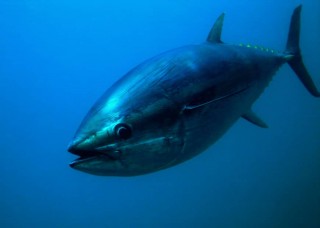Loading
Search
▼ Bluefin Tuna Catches Off Japan Sluggish As Fishers Curb Operations Due To Stricter Overfishing Rules
- Category:Event
Bluefin tuna catches in coastal waters off Japan have been sluggish so far in the current fishing season that runs from July 2018 to March this year.
Many fishers have apparently curbed operations following the introduction this season of stricter rules designed to tackle overfishing, with the total amount of catches standing at some 40 percent of the upper limit.
Bluefin tuna is a delicacy and used in top-quality sushi and other dishes.
An upper limit is set for each of the country’s 47 prefectures, on the basis of factors including past catches. This season, the total amount of catches of bluefin tuna weighing less than 30 kilograms each came to 651 tons in all prefectures as of Jan. 21, against a combined limit of 1,528.7 tons, and that of tuna weighing 30 kilograms or over stood at 480.4 tons, against a cap of 1,125.2 tons, according to the Fisheries Agency.
Bluefin tuna catches “are unlikely to surge during the remaining period” because the peak of the fishing season is already over in many areas, an official of the agency suggested.
Of all prefectures, only Chiba has seen its catches top its limit for tuna weighing less than 30 kilograms. The catch amount came to 39.4 tons, passing the cap of 36.3 tons.
“We had refrained from active fishing toward the end of last year, when bluefin tuna would be traded at high prices, but catches at year-end turned out to be poor,” said a fisher in Aomori.
Japan started to set prefecture-by-prefecture catch limits in 2016 for bluefin tuna weighing less than 30 kilograms.
But many continued to overfish the prized species or engaged in inappropriate fishing activities. Catches in Hokkaido in the season from July 2017 to June last year were about seven times greater than the maximum quota set for the prefecture.
To cope with the situation, the agency started this season to punish offenders and set prefectural catch limits for bigger bluefin tuna as well.
“Many fishers are unaccustomed to following such quotas,” the Aomori fisher said.
He also cited the need to create a system that allows prefectures whose catches are close to their limits to receive unused portions from prefectures with catches well below their quotas.
Many fishers have apparently curbed operations following the introduction this season of stricter rules designed to tackle overfishing, with the total amount of catches standing at some 40 percent of the upper limit.
Bluefin tuna is a delicacy and used in top-quality sushi and other dishes.
An upper limit is set for each of the country’s 47 prefectures, on the basis of factors including past catches. This season, the total amount of catches of bluefin tuna weighing less than 30 kilograms each came to 651 tons in all prefectures as of Jan. 21, against a combined limit of 1,528.7 tons, and that of tuna weighing 30 kilograms or over stood at 480.4 tons, against a cap of 1,125.2 tons, according to the Fisheries Agency.
Bluefin tuna catches “are unlikely to surge during the remaining period” because the peak of the fishing season is already over in many areas, an official of the agency suggested.
Of all prefectures, only Chiba has seen its catches top its limit for tuna weighing less than 30 kilograms. The catch amount came to 39.4 tons, passing the cap of 36.3 tons.
“We had refrained from active fishing toward the end of last year, when bluefin tuna would be traded at high prices, but catches at year-end turned out to be poor,” said a fisher in Aomori.
Japan started to set prefecture-by-prefecture catch limits in 2016 for bluefin tuna weighing less than 30 kilograms.
But many continued to overfish the prized species or engaged in inappropriate fishing activities. Catches in Hokkaido in the season from July 2017 to June last year were about seven times greater than the maximum quota set for the prefecture.
To cope with the situation, the agency started this season to punish offenders and set prefectural catch limits for bigger bluefin tuna as well.
“Many fishers are unaccustomed to following such quotas,” the Aomori fisher said.
He also cited the need to create a system that allows prefectures whose catches are close to their limits to receive unused portions from prefectures with catches well below their quotas.
- January 30, 2019
- Comment (0)
- Trackback(0)


